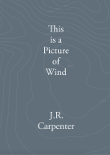This work expands upon a series of short texts written in response to the winter storms which battered South West England in early 2014, resulting in catastrophic flooding in Somerset and the destruction of the seawall and rail line at Dawlish in Devon. Following the news in the months after these storms, I was struck by the paradox presented by attempts to evoke through the materiality of language a force such as wind which we can only see indirectly through its affect. I began to explore weather in all its written forms.
Part poetic almanac, part private weather diary, and part live wind report for the South West of England, this work attempts to call attention to climate change by picturing through variations in language the disturbances and sudden absences left in the wake of wind.
This work is designed to be viewed on phones. It also works on computers. It responds to live weather data, so it will be slightly different each time you visit.
This is a Picture of Wind was commissioned by IOTA: DATA, with the support of the Canada Council for the Arts. In December 2018 IOTA released a free e-publication containing an essay about the work by Johanna Drucker: DYNAMIC POETICS: JR CARPENTER’S THIS IS A PICTURE OF WIND (PDF).
This is a Picture of Wind won the Opening Up Digital Fiction Competition People's Choice Award 2018 and was shortlisted for the New Media Writing Prize and the Robert Coover Award for a Work of Electronic Literature 2018, and was given Honourable Mention in the Public Library Prize for Electronic Literature. Initial research for this project was made possible by a Dot Award for Digital Literature, from if:book and the New Media Writing Prize.

A hard-cover print poetry collection based on this work published by Longbarrow Press June 2020, featuring an introduction by Johanna Drucker and a poetic response by Vahni Capildeo. The book has been listed in SPAM Press Deep Cuts 2020 and The Guardian's Best Poetry Books of 2020.
Special thanks to Michael & Utte, Gillian Sze, Mireille Bourgeois, Chris Meade, Kay Lovelace, Johanna Drucker, Vahni Capildeo, Brian Lewis, Emma Bolland, Michael Saunby, Peter Dickinson.
Further Reading:
Aristotle (1952 [350 BCE] Meteorologica, Lobe Classical Library, Harvard University Press
J. R. Carpenter (2017) The Gathering Cloud, Uniformbooks
John Clare (2014 [1827]) The Shepherd’s Calendar, Oxford University Press
Daniel Defoe (2005 [1704]) The Storm. Penguin Classics
Alexandra Harris (2016) Weatherland: Writers and Artist Under English Skies. London: Thames & Hudson, 2016
Luke Howard (1803) On the Modifications of Clouds. (PDF)
Luke Howard (1847) Barometrographia. London
Scott Huler (2004) Defining the Wind: The Beaufort Scale, and How a 19th-century Admiral Turned Science into Poetry.
NY: Crown Publishers
Lucretius (1951 [55 BCE]) The Nature of the Universe. London: Penguin Classics
Peter Moore (2015) The Weather Experiment: The Pioneers Who Sought to See the Future. London: Vintage
Lisa Robertson (2001) The Weather. London: Reality Street
John Ruskin (1899) The Queen of the Air: A Study of the Greek Myths of Cloud and Storm. London: George Allen
Gilbert White (1993 [1789]) The Natural History of Selborne. London: Thames & Hudson
National Meteorological Library and Archive, Met Office, Exeter, UK